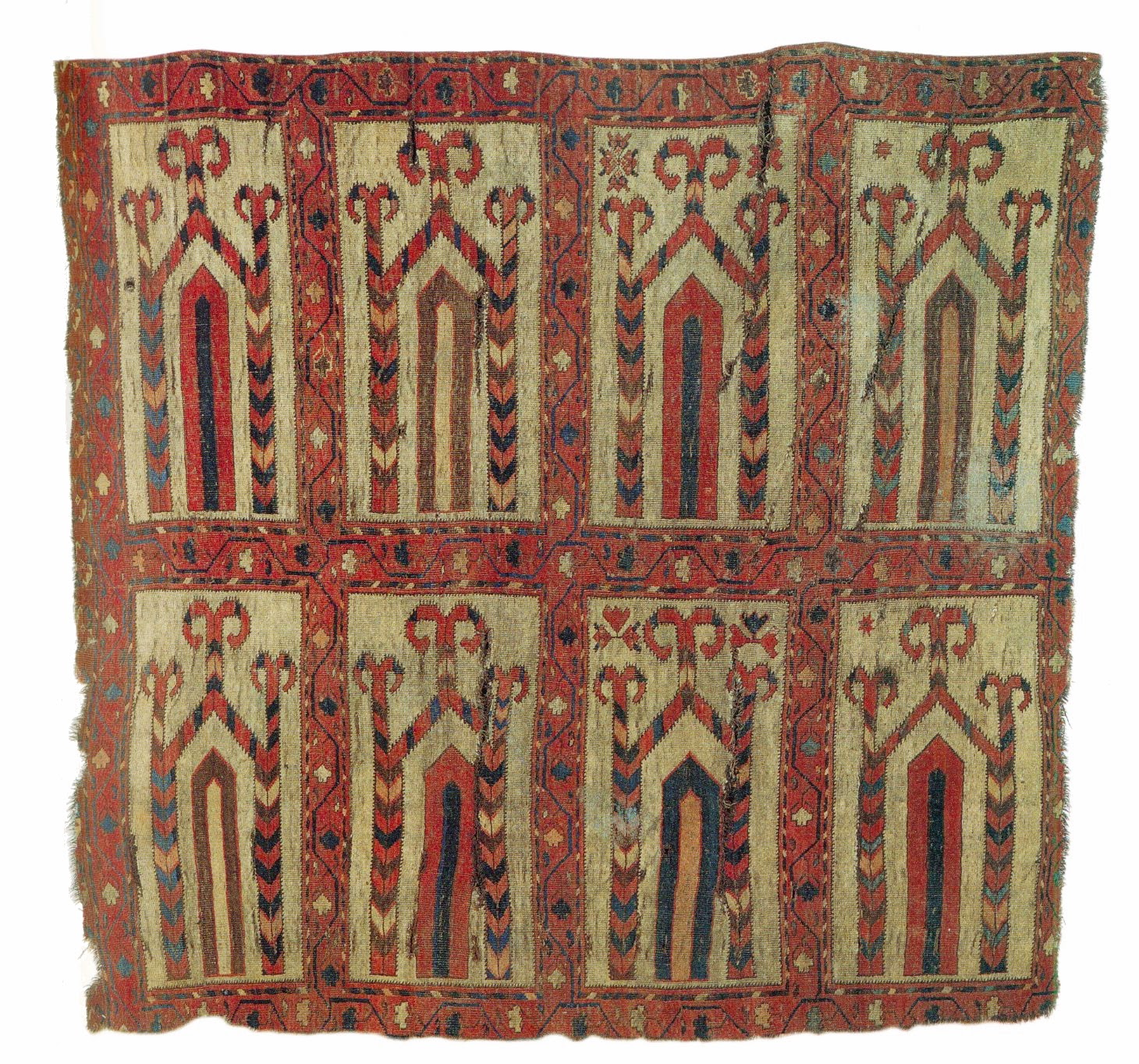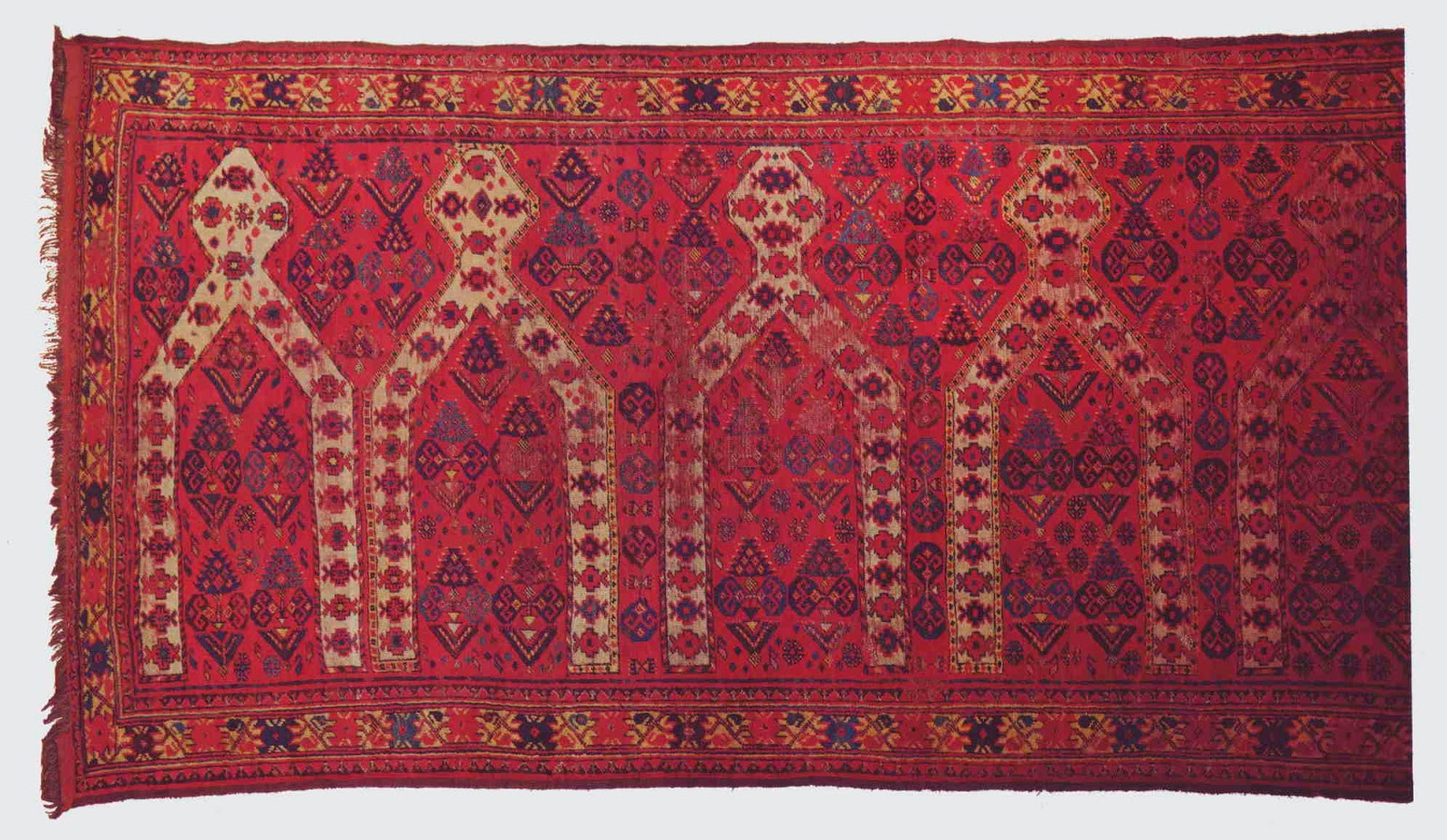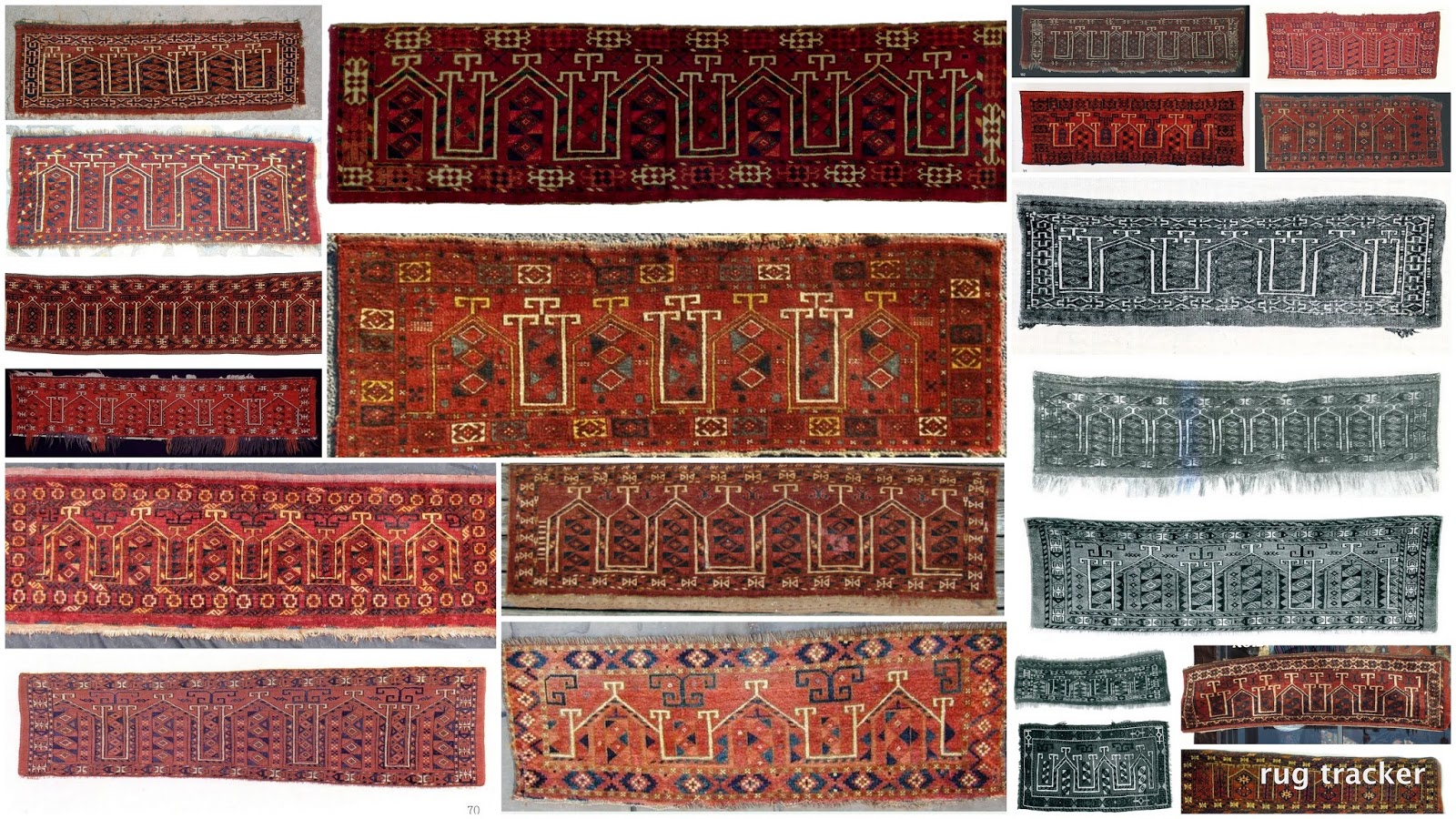East Turkestan experienced a popular upsurge in Saph-making during the 19th century,a curious fact considering the scarcity of conventional prayer rugs from the area
 |
| 158-CAR 89,Schurmann |
 |
| 159-Silk carpet,Herrmann,SOT X(109) |
The majority of examples were produced in the Khotan Oasis.It should be noted that the following divisions-Khotan,Kashgar,Yarkand-do not really define geographical areas of production,but rather aesthetic styles.The author has long been of the opinion that the majority of East Turki carpets were produced in the largest and most important area,Khotan.The differences in construction mirror different workshops and qualities.Thus the Khotan rugs are more rustic,the Kashgar carpets incorporate arabesque,and the Yarkand examples reflect a more aristocratic vein.
The Khotan Saphs can be divided into two groups.One has a Lotus head at the mihrab-apex,the other a rosette.The most common panel design is a tree of life design,sometimes varied with decorative panels in between,at other times as a simple repeat.The spandrel designs also vary from panel to panel,and the most complex examples feature both layouts.Sometimes the panels are identical but the colour changes,or else the spandrels differ.Through an apparently simple ground-plan incredibly complex variations are possible.Interestingly,the Khotan pieces with a rosette head in the field frequently feature a vase device out of which the plants grow.In the Lotus-head examples the Vases are mostly absent.
The most common version features 9 panels,but it is impossible to judge the exact width from photos of fragmented examples-7 panel versions are of course also prevalent.A classic model is the carpet purchased by Siegfried Troll in 1905
 |
| 160-MAK,Vienna |
Two examples with 3 panels employ the typical Mediterranean colouring but lack the vase device
 |
| 161-162-Above:Obendiek;Below:Milani |
A five door version at Grogan`s in 2007 employs the schematic tree of life with very pretty colouring-it is not initally clear that the panels all have the same design
 |
| 163-Grogan 10 December 2007(40) |
However the design can tire after 10 panels,in this case rescued by a rare curled-leaf border
 |
| 164-Bernheimer,Christies 14 February 1996(184) |
Two carpets illustrate the difficulties of reproducing the large Khotan Saphs in a small catalogue
 |
| 165-166- Christies 4 October 2011(216);Palais Kinski 16 May 2001(642) |
Whilst the Palais Kinski piece was a colour marvel,the following encapsulates the typical quirkiness of the Khotan group with its strange field inserts and down-turned branch-holders
 |
| 167-Sothebys 31 January 2014-105 |
Two last items from the Rosette-head group
 |
| 168-169- Nagels 12 November 1993(42);Sothebys 3 December 1988(101) |
The second Khotan group with a Lotus Palmette head in the mihrab often employs more complex field designs.The following also varies the border above and below the individual panels
 |
| 170-Sothebys 7 January 1981(75) |
The former, sold at Sothebys in 1981,features panels with a cloud-collar pattern and a variation of the Lotus Palmette.The cloud collar was also used on a four panel piece once with James Cohen
 |
| 171-172-Skinners 5 December 2009(186);James Cohen |
An awkward layout uses Besh-Gul,Pulao and Kochak field designs with a modulating border
 |
| 173-Sothebys 11 June 2002(76) |
Yet another complex field design was in the Straka Collection
 |
| 174 |
A simplified piece with spindly tree motif drawn without leaves succeeds through skillful colouring
 |
| 175-Christie 5 April 2011(85) |
Two further examples with conventional field(but lacking the vase device) are notable for their general liveliness
 |
| 176-177-Hoffmeister Collection;Lefevre October 1979(38) |
Another fragment from the Hoffmeister Collection reveals some of the working- methods of the Khotan weavers
 |
| 178-Hoffmeister Collection |
Tiered Saphs also occur,albeit rarely.A classic example was sold at Lefevre`s on 26 November 1982(11)
 |
| 179- |
Another curio,once with Joseph Lavian,has opposed panels,and is one of two known
 |
| 180-Phillips 11 September 1990(24) |
Another four examples have been published,two of which feature Kansu-type Yun Tsai borders
 |
| 181-182-13-184 |
A great rarity is the East Turki kilim Saph in the Wolf Collection
 |
| 185 |
What seem to constitute a pair feature a pictorial narrative design.The first was published by Parviz Tanavoli in Hali 40(15);the second appeared at Nagels on 15 November 1996(6)Both items are dated 1210,but this is perhapa a mistaken attempt at "1910" which would be more realistic.The meaning of this tale has yet to be deciphered,although an astrological background has been suggested
 |
| 186-187-Above:Tanavoli;below:Nagels |
Kashgar Saphs are amongst the most elegant of productions from the Tarim Basin.A major group features the Vase-flower design,a favourite of carpet makers since Safavid times.A three-panel version with typical blueish-red and emerald green appeared at Christies on 22 April 1999(144)
 |
| 188-Christies 1999 |
A delightful 5 door model was sold at Austrian Auctions on 15 March 2014(192)It is very much in the rustic Khotan manner and was thus described,but the design is Kashgar style
 |
| 189-Austrian Auctions |
Astute colour combinations disguise the fact that the panel theme is reiterated.Examples are known with a strict panel repeat
 |
| 190-191-Nagels 5 November 2002(203);Bernheimer |
A well-known example,later with Bausback,was published by Grote-Hasenbalg
 |
| 192-Jourdan 441 |
The severe look of a mechanically reproduced design can still exude real force
 |
| 193-TKF |
 |
| 194-Tabahi,Storia |
 |
| 195-Christies 15 October 1998(75) |
A last example in the group has all the requisites
 |
| 196-Phillips 12 April 1988(10) |
Five pieces from the Group without vase follow,of which the first two may once have been joined
 |
| 197-198-Schurmann,CAR 71;Sothebys 3 June 2005(61) |
Two examples continue the repeating mihrab theme
 |
| 199-200-Meschoulam,Hali 85-102;Keshishian 1970 |
A last piece from Eskenazi recalls the silk carpets in this style
 |
| 201-Eskenazi 290 |
 |
| 202-Silk carpet,Schurmann CAR 70 |
An unusual pair of carpets attributed to the Khotan zone may also be located to "Kashgar",and once put Hali`s APG reviewer in a quandry(Hali 98-141)
 |
| 203-Christies 11 february 1998(76) |
Printed upside down in the catalogue,the above was presumably thus woven in the manner of certain Turkish prayer rugs.It was first offered at Rippon Boswell`s in 1991,where it was catalogued as the carpet published in Neugebauer-Orendi(1909) The Christies example,consigned by Battilossi,sold for $46,575.
 |
| 204-Neugebauer-Orendi 1909,plate XVI |
Two last woolen carpets round off this Kashgar selection
 |
| 205-206-MAK;Trefoil XXIX |
The few examples which have been attributed to "Yarkand" are invariably of a stiff and monotonous type
 |
| 207-208-Munich ICOC 1978(107);Meschoulam,Hali 6-3-17 |
 |
| 209-210-Cohen,1983(CIV);Christies 17 October 1996(433) |
In general less playful,these pieces probably fulfilled a more serious purpose than the "tea-house"style Khotans.
SILK
Three types of silk Saphs from the area are known:a silk-metal group woven in Polonaise technique with coarse metal ground in the mihrabs and spandrels,previously analysed by the author in Ghereh: link ;a group with vase and pommegranate designs;and a last batch with plain field mihrabs.
The Graf Silk Metal Group.
The author has described the Graf Silk and Metal Saph in Ghereh 37.It was first published by Karabacek in 1881,and thereafter consequently misattributed.Its present whereabouts are unknown.Of four other pieces,one is in the MAK,another is associated with the Victoria and Albert Museum London,a further piece is housed in Berlin,and a fifth appeared at Christies on 7 October 2014,fetching £15,000.
Here the original repro from Karabacek of the Graf Saph
 |
| 211-Karabacek |
next the MAK`s example,attributed to Graf but probably a carpet brought back from East Turkestan by Siegfried Troll.Careful study reveals clear differences in the drawing of the last,righthand panel
 |
| 212-MAK |
A carpet in the V&A was published by Kendrick and in the catalogue to the Franco-British Exhibition
 |
| 213-Lady Cunliffe |
The Berlin example entered the Museum in 1974
 |
| 214-Berlin |
The Christies fragment most resembles the Berlin example
 |
| 215-Christies 2014 |
The Pommegranate Vase Group.
As noted in the section on Indian carpets,this design has been taken from 18th-19th century Deccani carpets.Perhaps Indian masters were at work here, a large group of Kashmiri tradesmen were known to have settled in the Tarim Basin.The first example appeared at Phillips in 1987
 |
| 216-Phillips 24 February 1987(2) |
A second example was auctioned in 1989,first at Mangisch,and shortly afterwards at Sothebys.It features a solitary panel with sickle-moon,and a vase with long-stem flower
 |
| 217-Mangisch April 1989;Sothebys 19 July 1989(54) |
A third example,attributed to Yarkand and priced at 75,000 Deutschmark, was published by E.Herrmann in SOT VIII
 |
| 218-SOT 8-113 |
A last example lately went unsold at Christies London on 7 October 2014(83)It is notable for having a soumak counterpart,one of only two known pieces in this technique from East Turkestan
 |
| 219-220-Christies 2014;Soumak,Private Collection |
Plain field Mihrabs
Another five silk rugs with plain green to yellow green fields are known.The carpet in the MAK,Vienna is representative
 |
| 221-MAK |
What may have once formed part of the same piece was sold at Edelmanns New York in 1981
 |
| 222-Edelmann |
After an appearance at a provincial auction the following duly appeared as an advert for Vigo Galleries,later re-surfacing at Phillips in 1994(sold for $7,765)
 |
| 223-Phillips-Vigo-Phillips 26 April 1994(27) |
Two carpets with a more yellowish field colour appeared successively at Sothebys in 1999(12 October) and 2000(12 April)
 |
| 224-225-Sothebys |
LAST BUT NOT LEAST
A piece from the Quill Jones Sale of 1952 was in the Schurmann Kashgar style
 |
| 226-Quill Jones 115 |
Offered at Sothebys Islamic sale on 18 July 1984(309)was a carpet full of variety and modulating border
 |
| 227-Sothebys 1984 |
A piece from Christies 1985 sale,with Kansu influence, later appeared in the fourth Hali Annual
 |
| 228-Christies 17 October 1985(5) |
An "Italian" style Saph went unsold at Christies on 8 October 2013(53)
 |
| 229-Christies 2013 |
Long-time detainees in Indian Jails were(and still are)taught to weave dhurries,the Indian kilim.A very common design is the repeating Saph,accompanied by vertical stripes,which recall the bars of their cells-the other side of Paradise
 |
| 230-231-232-233-234 |
 |
| 235 |









































